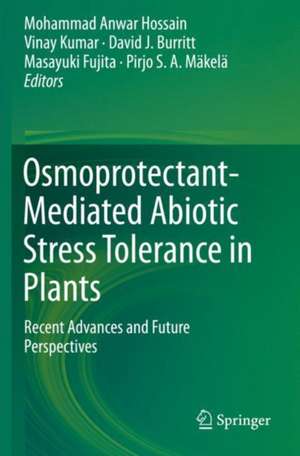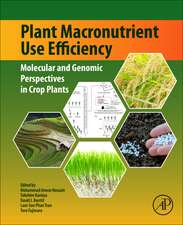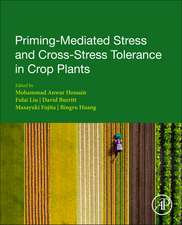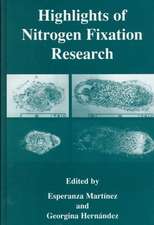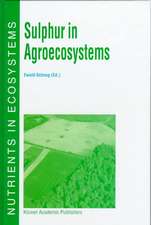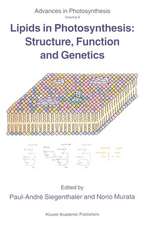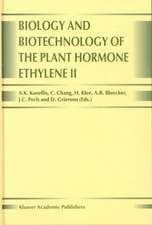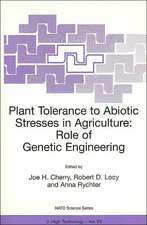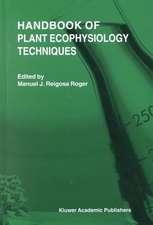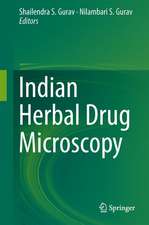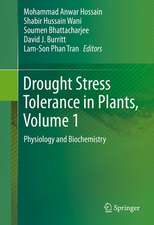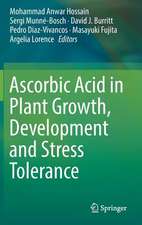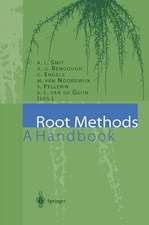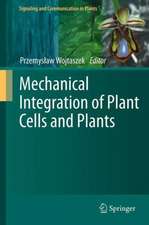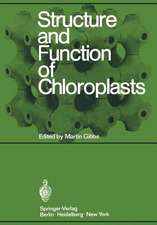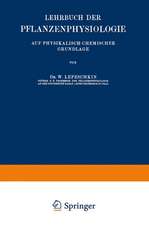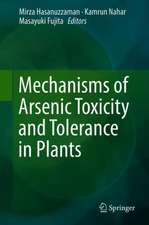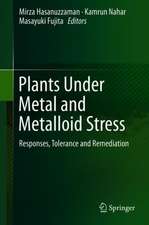Osmoprotectant-Mediated Abiotic Stress Tolerance in Plants: Recent Advances and Future Perspectives
Editat de Mohammad Anwar Hossain, Vinay Kumar, David J. Burritt, Masayuki Fujita, Pirjo S. A. Mäkeläen Limba Engleză Paperback – 13 noi 2020
In this book, Osmoprotectant-mediated abiotic stress tolerance in plants: recent advances and future perspectives, we present a collection of 16 chapters written by leading experts engaged with compatible solute-induced abiotic stress tolerance in plants. The main objective of this volume is to promote the important roles of these compatible solutes in plant biology, by providing an integrated and comprehensive mix of basic and advanced information for students, scholars and scientists interested in, or already engaged in, research involving osmoprotectant. Finally, this book will be a valuable resource for future environmental stress-related research, and can be considered as a textbook for graduate students and as a reference book for front-line researchers working on the relationships between osmoprotectant and abiotic stress responses and tolerance in plants.
| Toate formatele și edițiile | Preț | Express |
|---|---|---|
| Paperback (1) | 947.35 lei 6-8 săpt. | |
| Springer International Publishing – 13 noi 2020 | 947.35 lei 6-8 săpt. | |
| Hardback (1) | 953.35 lei 6-8 săpt. | |
| Springer International Publishing – 13 noi 2019 | 953.35 lei 6-8 săpt. |
Preț: 947.35 lei
Preț vechi: 1155.30 lei
-18% Nou
Puncte Express: 1421
Preț estimativ în valută:
181.33€ • 197.03$ • 152.42£
181.33€ • 197.03$ • 152.42£
Carte tipărită la comandă
Livrare economică 21 aprilie-05 mai
Preluare comenzi: 021 569.72.76
Specificații
ISBN-13: 9783030274252
ISBN-10: 303027425X
Ilustrații: XI, 342 p. 44 illus., 41 illus. in color.
Dimensiuni: 155 x 235 mm
Greutate: 0.5 kg
Ediția:1st ed. 2019
Editura: Springer International Publishing
Colecția Springer
Locul publicării:Cham, Switzerland
ISBN-10: 303027425X
Ilustrații: XI, 342 p. 44 illus., 41 illus. in color.
Dimensiuni: 155 x 235 mm
Greutate: 0.5 kg
Ediția:1st ed. 2019
Editura: Springer International Publishing
Colecția Springer
Locul publicării:Cham, Switzerland
Cuprins
1.Osmoprotectant-related genes in plants under abiotic stress: expression dynamics, in silico genome mapping, and biotechnology.-2.Proline metabolism and its functions in development and stress tolerance.-3. Regulation of proline accumulation and its molecular and physiological functions in stress defence.- 4. Exogenous proline-mediated abiotic stress tolerance in plants: possible mechanisms 5.-Biosynthesis and degradation of glycine betaine and its potential to control plant growth and development.- 6. Exogenous glycinebetaine-mediated modulation of abiotic stress tolerance in plants: possible mechanisms.- 7. Roles of endogenous glycinebetaine in plant abiotic stress responses.- 8.Biosynthesis and degradation of trehalose, and its potential to control .- 9. Proline, glycinebetaine and trehalose uptake and inter-organ transport in plants under stress.- 10. Transgenic plants overexpressing trehalose biosynthetic genes and abiotic stress tolerance in plants.- 11. The role of proline, glycine betaine and trehalose in stress responsive gene expression.- 12. Seed osmolyte priming and abiotic stress tolerance.- 13. Relationship between polyamines and osmoprotectants in the response to salinity of the legume-rhizobia symbiosis.- 14. Engineering polyamines metabolic pathways for abiotic stress tolerance in plants.-15. Fructan metabolism in plant growth and development and stress tolerance.-
Notă biografică
Dr. Mohammad Anwar Hossain is a Professor in the Department of Genetics and Plant Breeding, Bangladesh Agricultural University, Mymensingh-2202, Bangladesh. He received his B.Sc. in Agriculture and M.S. in Genetics and Plant Breeding from Bangladesh Agricultural University, Bangladesh. He also received an M.S. in Agriculture from Kagawa University, Japan in 2008 and a Ph.D. in Abiotic Stress Physiology and Molecular Biology from Ehime University, Japan in 2011 through Monbukagakusho scholarship. As a JSPS postdoctoral researcher he has worked on isolating low phosphorus stress tolerant genes from rice at the university of Tokyo, Japan during the period of 2015-2017. His current research interests include the isolation and characterization of abiotic stress responsive genes and proteins, physiological and molecular mechanisms of abiotic stress response and tolerance with special reference to oxidative stress, antioxidants and methylglyoxal metabolism and signaling, generation ofstress tolerant and nutrient efficient plants through breeding and biotechnology and cross-stress tolerance in plants. He has over 50 peer-reviewed publications and has edited 9 books, including this one, published by CRC press, Springer, and Elsevier.
Dr. Vinay Kumar is an Associate Professor in the Department of Biotechnology, Modern College, Ganeshkhind, Pune, India and a Visiting Faculty at the Department of Environmental Sciences, Savitribai Phule University, Pune, India. He obtained his Ph.D. in Biotechnology from Savitribai Phule Pune University (Formerly University of Pune) in 2009. For his Ph.D., he worked on metabolic engineering of rice for improved salinity tolerance. He has published 40 peer reviewed research/ review articles, edited 4 books, including this one, published by Springer and Wiley. He is a recipient of Young Scientist Award of Science and Engineering Board, Government of India. His current research interests include elucidating molecular mechanisms underlying salinity stress responses and tolerance in plants.
Dr. David J. Burritt is an Associate Professor in the Department of Botany, The University of Otago, Dunedin, New Zealand. He received his B.Sc. and M.Sc. (hons) in Botany, and his Ph.D. in Plant Biotechnology from The University of Canterbury, Christchurch, New Zealand. His research interests include oxidative stress and redox biology, plant based foods and bioactive molecules, plant breeding and biotechnology, cryopreservation of germplasm, and the stress biology of plants, animals and algae. He has over 100 peer-reviewed publications and has edited 4 books for Springer and 3 for Elsevier.
Dr. Masayuki Fujita is a Professor in the Department of Plant Science, Faculty of Agriculture, Kagawa University, Kagawa, Japan. He received his B.Sc. in Chemistry from Shizuoka University, Shizuoka, and his M.Agr. and Ph.D. in Plant Biochemistry from Nagoya University, Nagoya, Japan. His research interests include physiological, biochemical and molecular biological responses based on secondary metabolism in plants under biotic (pathogenic fungal infection) and abiotic (salinity, drought, extreme temperatures and heavy metals) stresses; phytoalexin, cytochrome P-450, glutathione S-transferase, phytochelatin and redox reaction and antioxidants. He has over 150 peer-reviewed publications and has edited 10 books including this one.
Dr. Pirjo Mäkelä is a Professor in the Department of Agricultural Sciences, University of Helsinki, Finland. She received her MSc and PhD in Crop Science from the University of Helsinki, Finland. Her research interests includes physiological, biochemical, and agronomical responses of plants to abiotic stresses, such as water deficit and salinity, as well as ways to minimize the effects of abiotic stresses on yield formation and quality of yield. She is also interested in activelearning in higher education. She has over 70 peer-reviewed publications and she has edited 3 books including this one.
Textul de pe ultima copertă
In nature, plants are constantly challenged by various abiotic and biotic stresses that can restrict their growth, development and yields. In the course of their evolution, plants have evolved a variety of sophisticated and efficient mechanisms to sense, respond to, and adapt to changes in the surrounding environment. A common defensive mechanism activated by plants in response to abiotic stress is the production and accumulation of compatible solutes (also called osmolytes). This include amino acids (mainly proline), amines (such as glycinebetaine and polyamines), and sugars (such as trehalose and sugar alcohols), all of which are readily soluble in water and non-toxic at high concentrations. The metabolic pathways involved in the biosynthesis and catabolism of compatible solutes, and the mechanisms that regulate their cellular concentrations and compartmentalization are well characterized in many important plant species. Numerous studies have provided evidence that enhanced accumulation of compatible solutes in plants correlates with increased resistance to abiotic stresses. New insights into the mechanisms associated with osmolyte accumulation in transgenic plants and the responses of plants to exogenous application of osmolyte, will further enhance our understanding of the mechanisms by which compatible solutes help to protect plants from damage due to abiotic stress and the potential roles compatible solutes could play in improving plants growth and development under optimal conditions for growth. Although there has been significant progress made in understanding the multiple roles of compatible solute in abiotic stress tolerance, many aspects associated with compatible solute-mediated abiotic stress responses and stress tolerance still require more research. As well as providing basic up-to-date information on the biosynthesis, compartmentalization and transport of compatible solute in plants, this book will also give insights into the direct or indirect involvement of these key compatible solutes in many important metabolic processes and physiological functions, including their antioxidant and signaling functions, and roles in modulating plant growth, development and abiotic stress tolerance.
In this book, Osmoprotectant-mediated abiotic stress tolerance in plants: recent advances and future perspectives, we present a collection of 16 chapters written by leading experts engaged with compatible solute-induced abiotic stress tolerance in plants. The main objective of this volume is to promote the important roles of these compatible solutes in plant biology, by providing an integrated and comprehensive mix of basic and advanced information for students, scholars and scientists interested in, or already engaged in, research involving osmoprotectant. Finally, this book will be a valuable resource for future environmental stress-related research, and can be considered as a textbook for graduate students and as a reference book for front-line researchers working on the relationships between osmoprotectant and abiotic stress responses and tolerance in plants.
In this book, Osmoprotectant-mediated abiotic stress tolerance in plants: recent advances and future perspectives, we present a collection of 16 chapters written by leading experts engaged with compatible solute-induced abiotic stress tolerance in plants. The main objective of this volume is to promote the important roles of these compatible solutes in plant biology, by providing an integrated and comprehensive mix of basic and advanced information for students, scholars and scientists interested in, or already engaged in, research involving osmoprotectant. Finally, this book will be a valuable resource for future environmental stress-related research, and can be considered as a textbook for graduate students and as a reference book for front-line researchers working on the relationships between osmoprotectant and abiotic stress responses and tolerance in plants.
Caracteristici
Valuable resource for future environmental stress-related research Reference for front-line researchers working on the relationships between proline, glycinebetaine and trehalose and environmental stress responses and tolerance Up-to-date contributions by an international panel of researchers
